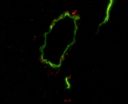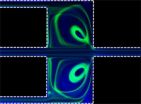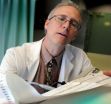(Press-News.org) When someone develops liver cancer, the disease introduces a very subtle difference to their bloodstream, increasing the concentration of a particular molecule by just 10 parts per billion.
That small shift is difficult to detect without sophisticated lab equipment – but perhaps not for long. A new "lab on a chip" designed by Brigham Young University professor Adam Woolley and his students reveals the presence of ultra-low concentrations of a target molecule.
As the BYU researchers report in the journal Analytical Chemistry, their experiments detected as little as a single nanogram – one billionth of a gram – of the target molecule from a drop of liquid. And instead of sending the sample to a lab for chemical analysis, the chip allows them to measure with such precision using their own eyes.
"The nice thing about the system that we have developed is that this could be done anywhere," Woolley said. "Somebody could put the sample in, look at it, and have the result they need."
The trick is to line a tiny pipe with receptors that catch a specific molecule and allow others to pass by. When a drop of liquid is placed on the clear chip, capillary action draws the fluid through the channel, flowing up to one centimeter per second. As more of the target molecules are snagged by the receptors, the space constricts and eventually stops the flow.
How far the sample flows is a direct indication of the concentration of the target molecule (higher concentration = shorter distance, lower concentration = longer distance).
"The accuracy gained with this system should make it competitive with more expensive and complicated immunoassay systems," said Chuck Henry, a chemist at Colorado State University who was not affiliated with the project.
Woolley and his students hope their prototype will work as a blueprint for making inexpensive diagnostic tests for a variety of diseases and genetic disorders.
"There are a lot of molecules associated with diseases where concentrations around a nanogram per milliliter or less in blood are the difference between a disease state versus a healthy state," Woolley said.
### Four students worked on the project, led by graduate student Debolina Chatterjee of New Delhi, India. She and fellow grad student Danielle Mansfield mentored two undergraduates on the project, Neil Anderson and Sudeep Subedi.
The experience helped Anderson gain admission into law school at Cornell, where he is studying patent law. Subedi is completing a degree in clinical laboratory science and plans to eventually return to his homeland of Nepal and help establish better medical infrastructure.
Measuring molecules with the naked eye
Chemists' innovation may be a better model for disease diagnostic kits
2012-10-26
ELSE PRESS RELEASES FROM THIS DATE:
Elevated formaldehyde levels found in day care centers
2012-10-26
Berkeley — A new, comprehensive survey of day care centers by University of California, Berkeley, researchers found that, overall, the environmental quality in child care settings was similar to other indoor environments, but that levels of formaldehyde and several other contaminants exceeded state health guidelines. Cleaning- and sanitizing-related chemicals were also present in the air, and sometimes at higher levels, than in comparable studies on homes.
The study, funded by the California Air Resources Board (CARB), is the first detailed analysis of environmental contaminants ...
Efforts to mitigate climate change must target energy efficiency
2012-10-26
Much more must be done to develop energy efficient cars, buildings and domestic appliances to address climate change – according to new research from the Tyndall Centre for Climate Change Research at the University of East Anglia.
A report published today in Nature Climate Change shows that twice as much effort is being spent on developing energy supply technologies - such as new power stations - than is spent on improving the efficiency with which energy is used.
The research shows that efficient end-use technologies have the potential to contribute large emission ...
Watching the cogwheels of the biological clock in living cells
2012-10-26
Our master circadian clock resides in a small group of about 10'000 neurons in the brain, called the suprachiasmatic nucleus. However, similar clocks are ticking in nearly all cells of the body, as demonstrated by the group of Ueli Schibler, professor at the Department of Molecular Biology of the University of Geneva, Switzerland. The molecular mechanisms of circadian clocks can thus be studied outside of the animals, in cultured cells.
A system to study gene regulation live in single cells
"Given the important role of the DBP protein in the regulation of detoxifying ...
Researchers decipher the mecanism of membrane fission
2012-10-26
A cell is composed of a nucleus which encloses its genetic information and the cytoplasm which is itself confined by an external membrane separating the cell from the outside world. The impermeability of the membrane and its ability to repair itself protect the cell from its environment. Although this membrane resistance is fundamental to the survival of the cell, the cell also needs to let in particles necessary for its proper functioning. The mechanism by which a small region of the cytoplasmic membrane invaginates to form a bud that will then be sectioned off to let ...
Salk study finds diabetes raises levels of proteins linked to Alzheimer's features
2012-10-26
Growing evidence suggests that there may be a link between diabetes and Alzheimer's disease, but the physiological mechanisms by which diabetes impacts brain function and cognition are not fully understood. In a new study published in Aging Cell, researchers at the Salk Institute for Biological Studies show, for the first time, that diabetes enhances the development of aging features that may underlie early pathological events in Alzheimer's.
Specifically, the Salk team found increases in two hallmarks of Alzheimer's-accumulations of amyloid beta (Abeta) and tau protein-in ...
Footwear forensics
2012-10-26
A new computer algorithm can analyze the footwear marks left at a crime scene according to clusters of footwear types, makes and tread patterns even if the imprint recorded by crime scene investigators is distorted or only a partial print.
Footwear marks are found at crime scenes much more commonly than fingerprints, writes a team from the University at Buffalo, New York, in a forthcoming issue of the International Journal of Granular Computing, Rough Sets and Intelligent Systems. They point out that while footprints are common they are often left unused by forensic scientists ...
'NHS should replace traditional autopsies with non-invasive alternative'
2012-10-26
The NHS should implement a non-invasive alternative to autopsies, according to a Department of Health-commissioned report by leading UK experts within the field of post-mortem cross-sectional imaging.
The NHS Implementation Sub-Group of the Department of Health's Post Mortem, Forensic and Disaster Imaging Group (PMFDI) has called on the NHS to adopt post-mortem cross-sectional imaging for as an adjunct to, and under the right circumstances, a replacement for autopsies.
The group, chaired by Professor Guy Rutty, Chief Forensic Pathologist to the East Midlands Forensic ...
Media and content digitization benefits consumers, but revenues lag behind
2012-10-26
Digital spending - the acquisition of media products in digital format - tripled from 2006 to 2010 worldwide, with the recording music sector now achieving 30% of its global sales in the digital market. The digital success of the music sector contrasts other media and content industries, which are moving at a slower pace towards digital with distribution. Only 6% of film/video, newspapers, magazines and book sales were digital, according to the Joint Research Centre's (JRC) report on "The media and content industries. A quantitative overview", which represents an important ...
New options for ease and accuracy in extraction of rare cells or separating blood
2012-10-26
At the Sixteenth International Conference on Miniaturized Systems for Chemistry and Life Sciences (microTAS) to be held Oct. 28-Nov. 1, in Okinawa, Japan, University of Cincinnati researchers will present four papers, including one detailing improvements in rare cell isolation and one detailing improvements, in terms of cost and time, of common blood tests.
Ian Papautsky, associate professor in UC's School of Electronic and Computing Systems (SECS), part of the College of Engineering and Applied Science, and a UC team are leading these research efforts.
In a paper titled ...
Magnetic brain stimulation treats depression independent of sleep effect
2012-10-26
AUGUSTA, Ga. – While powerful magnetic stimulation of the frontal lobe of the brain can alleviate symptoms of depression, those receiving the treatment did not report effects on sleep or arousal commonly seen with antidepressant medications, researchers say.
"People's sleep gets better as their depression improves, but the treatment doesn't itself cause sedation or insomnia." said Dr. Peter B. Rosenquist, Vice Chair of the Department of Psychiatry and Health Behavior at the Medical College of Georgia at Georgia Health Sciences University.
The finding resulted from ...
LAST 30 PRESS RELEASES:
Scientists use ultrasound to soften and treat cancer tumors without damaging healthy tissue
Community swimming program for Black youth boosts skills, sense of belonging, study finds
Specific depressive symptoms in midlife linked to increased dementia risk
An ‘illuminating’ design sheds light on cholesterol
Who is more likely to get long COVID?
Study showcases resilience and rapid growth of “living rocks”
Naval Research Lab diver earns Office of Naval Research 2025 Sailor of the Year
New Mayo-led study establishes practical definition for rapidly progressive dementia
Fossil fuel industry’s “climate false solutions” reinforce its power and aggravate environmental injustice
Researchers reveal bias in a widely used measure of algorithm performance
Alcohol causes cancer. A study from IOCB Prague confirms damage to DNA and shows how cells defend against it
Hidden viruses in wastewater treatment may shape public health risks, study finds
Unlock the power of nature: how biomass can transform climate mitigation
Biochar reshapes hidden soil microbes that capture carbon dioxide in farmland
Reducing saturated fat intake shows mortality benefit, but only in high-risk individuals
Manta rays create mobile ecosystems, study finds
Study: Mixed results in using lipoic acid to treat progressive multiple sclerosis
Norbert Holtkamp appointed director of Fermi National Accelerator Laboratory
New agentic AI platform accelerates advanced optics design
Biologists discover neurons use physical signals — not electricity — to stabilize communication
Researchers discover that a hormone can access the brain by hitchhiking
University of Oklahoma researcher awarded funding to pursue AI-powered material design
Exploring how the visual system recovers following injury
Support for parents with infants at pediatric check-ups leads to better reading and math skills in elementary school
Kids’ behavioral health is a growing share of family health costs
Day & night: Cancer disrupts the brain’s natural rhythm
COVID-19 vaccination significantly reduces risk to pregnant women and baby
The role of vaccination in maternal and perinatal outcomes associated with COVID-19 in pregnancy
Mayo Clinic smartwatch system helps parents shorten and defuse children's severe tantrums early
Behavioral health spending spikes to 40% of all children’s health expenditures, nearly doubling in a decade
[Press-News.org] Measuring molecules with the naked eyeChemists' innovation may be a better model for disease diagnostic kits



